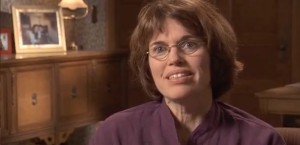There are ways of looking at photos and composition in cinematography that may be hard-wired in our brains. Long ago the Greeks came up with the “golden rule” or the “rule of thirds.” This is also used in writing, where two examples are not enough, four are too many, but three seems just right. The rule of three, or rule of thirds, influenced classical drawing and sculpture and influences us today. The logos shown here use this rule of three in various ways. What do these logos or symbols say to you? Do they convey calm competence and creative stability?
After the Greeks, the Germans put into words a theory about how our minds perceive and process visual input. They called it “Gestalt theory,” named after the German word for shape. One of the elements of Gestalt theory is equilibrium. We seem to need it for some reason. When equilibrium is off (hopefully by design) the effect can be either jarring or attention grabbing.
One well-used technique in interviewing is to give the subject some nose-room and frame the person slightly to one side and looking toward the center of the frame (either right or left). A disturbing new trend in news shooting is to place the interview subject smack dab in the middle. Everything is in focus and the subject is dead center.  This framing technique isn’t used at small-market news stations either. The image of Bill Gates is from a major network interview and there is Bill – perfectly centered.
This framing technique isn’t used at small-market news stations either. The image of Bill Gates is from a major network interview and there is Bill – perfectly centered. The second image is from another major network, making the same framing decision. Except he has a pole directly behind his head.
The second image is from another major network, making the same framing decision. Except he has a pole directly behind his head.
It’s actually a little disconcerting, don’t you think? Finding interesting ways to compose an on-camera interview is something that is a frequent challenge in commercials, documentaries, sports programs and corporate videos.  It can be done as in this interview from a documentary film.
It can be done as in this interview from a documentary film.
Gestalt theory also speaks to equilibrium which can be pleasing to the eye, but can also be less interesting. Photographer and writer Michael Fulks says that “When your eyes have nowhere else to go, you get bored and go off to find more stimulation – your hand to turns the page, or your feet to move on to the next picture. Not exactly what the artist has in mind.”
In the framing of this interview, there is balance and both subjects are facing toward the center, although the big picture window in the center is (unintentionally) the third interview subject. In fact, the window is hogging the attention.
Fulks continues: “So how do you achieve a balance or equilibrium if you don’t place subjects in the middle? The rule of thirds is a start. Remember that the rule of thirds does not merely describe four points in space; it also describes four axes.”
The composition of the image on the screen says a great deal to your audience. Let’s hope that what you say is intentional!
Source: Apogee Photo Magazine, “Gestalt Theory and Photographic Composition: Equilibrium,” Michael Fulks






